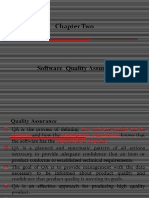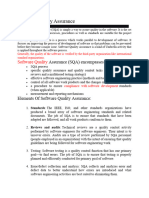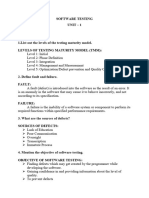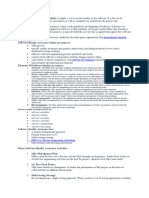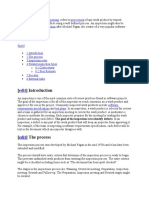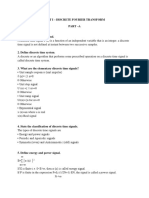0 ratings0% found this document useful (0 votes)
61 viewsUnit: 5 Test Automation
Unit: 5 Test Automation
Uploaded by
indhuProject monitoring and controlling involves checking the status of projects, preparing reports comparing actual work to planned work, and developing corrective actions when deviations from plans are detected. Milestones are tangible events expected to occur at certain times, and are used to determine project status. Software configuration management identifies, organizes, and controls changes throughout a software lifecycle. Baselines are formally reviewed versions from which changes are measured and can only be changed through formal procedures. Version control manages different object versions, while change control evaluates and applies changes in a controlled manner. Testing reveals defects and evaluates quality, while reviews evaluate software artifacts and identify components needing improvement or conforming to standards. Review benefits include higher quality, productivity, reduced costs, and satisfaction.
Copyright:
© All Rights Reserved
Available Formats
Download as PDF, TXT or read online from Scribd
Unit: 5 Test Automation
Unit: 5 Test Automation
Uploaded by
indhu0 ratings0% found this document useful (0 votes)
61 views2 pagesProject monitoring and controlling involves checking the status of projects, preparing reports comparing actual work to planned work, and developing corrective actions when deviations from plans are detected. Milestones are tangible events expected to occur at certain times, and are used to determine project status. Software configuration management identifies, organizes, and controls changes throughout a software lifecycle. Baselines are formally reviewed versions from which changes are measured and can only be changed through formal procedures. Version control manages different object versions, while change control evaluates and applies changes in a controlled manner. Testing reveals defects and evaluates quality, while reviews evaluate software artifacts and identify components needing improvement or conforming to standards. Review benefits include higher quality, productivity, reduced costs, and satisfaction.
Original Description:
585
Original Title
UNIT5
Copyright
© © All Rights Reserved
Available Formats
PDF, TXT or read online from Scribd
Share this document
Did you find this document useful?
Is this content inappropriate?
Project monitoring and controlling involves checking the status of projects, preparing reports comparing actual work to planned work, and developing corrective actions when deviations from plans are detected. Milestones are tangible events expected to occur at certain times, and are used to determine project status. Software configuration management identifies, organizes, and controls changes throughout a software lifecycle. Baselines are formally reviewed versions from which changes are measured and can only be changed through formal procedures. Version control manages different object versions, while change control evaluates and applies changes in a controlled manner. Testing reveals defects and evaluates quality, while reviews evaluate software artifacts and identify components needing improvement or conforming to standards. Review benefits include higher quality, productivity, reduced costs, and satisfaction.
Copyright:
© All Rights Reserved
Available Formats
Download as PDF, TXT or read online from Scribd
Download as pdf or txt
0 ratings0% found this document useful (0 votes)
61 views2 pagesUnit: 5 Test Automation
Unit: 5 Test Automation
Uploaded by
indhuProject monitoring and controlling involves checking the status of projects, preparing reports comparing actual work to planned work, and developing corrective actions when deviations from plans are detected. Milestones are tangible events expected to occur at certain times, and are used to determine project status. Software configuration management identifies, organizes, and controls changes throughout a software lifecycle. Baselines are formally reviewed versions from which changes are measured and can only be changed through formal procedures. Version control manages different object versions, while change control evaluates and applies changes in a controlled manner. Testing reveals defects and evaluates quality, while reviews evaluate software artifacts and identify components needing improvement or conforming to standards. Review benefits include higher quality, productivity, reduced costs, and satisfaction.
Copyright:
© All Rights Reserved
Available Formats
Download as PDF, TXT or read online from Scribd
Download as pdf or txt
You are on page 1of 2
UNIT: 5 TEST AUTOMATION
1. Define Project monitoring or tracking.
Project monitoring refers to the activities and tasks managers engage into periodically
check the status of each project .Reports are prepared that compare the actual work done to
the work that was planned.
2. Define Project Controlling.
It consists of developing and applying a set of corrective actions to get a project on
track when monitoring shows a deviation from what was planned .
3. Define Milestone.
MileStones are tangible events that are expected to occur at a certain time in the
projects life time .Mnagers use them to determine project status.
4. Define SCM (Software Configuration management).
Software Configuration Management is a set of activities carried out for identifying,
organizing and controlling changes throughout the lifecycle of computer software.
5. Define Base line.
Base lines are formally reviewed and agreed upon versions of software artifacts,
from which all changes are measured. They serve as the basis for futher development and
can be changed only through formal change procedures.
6. Differentiate version control and change control.
Version Control combines procedures and tools to manage different versions of
configuration objects that are created during software process.
Change control is a set of procedures to evaluate the need of change and apply the
changes requested by the user in a controlled manner.
7. What is Testing?
Testing is generally described as a group of procedures carried out to evaluate
some aspect of a piece of software.It used for revealing defect in software and to evaluate
degree of quality.
8. Define Review.
Review is a group meeting whose purpose is to evaluate a software artifact or a
set of software artifacts.
9. What are the goals of Reviewers?
Identify problem components or components in the software artifact that need
improvement.
Identify components of the software artifact that donot need improvement.
Identify specific errors or defects in the software artifact.
Ensure that the artifact confirms to organizational standards.
10. What are the benefits of a Review program?
Higher quality software
Increased productivity
Increased awareness of quality issues
Reduced maintenance costs
Higher customer satisfaction
11. What are the Various types of Reviews?
Inspections
WalkThroughs
12. What is Inspections?
It is a type of review that is formal in nature and requires prereview preparation on
the part of the review team.the Inspection leader prepares is the checklist of items that
serves as the agenda for the review.
13. What is WalkThroughs?
It is a type of technical review where the producer of the reviewed material serves as
the review leader and actually guides the progression of the review .It have traditionally
been applied to design and code.
14. List out the members present in the Review Team.
SQA(Software Quality Assurance) staff
Testers
Developers
Users /Clients.
Specialists.
15. List the components of review plans.
Review Goals
Items being reviewed
Preconditions for the review.
Rolls,Team size,participants.
Training requirements.
Review steps.
Time requirements
You might also like
- Human Resource Management Information System (HRMIS) : Group No: 6Document19 pagesHuman Resource Management Information System (HRMIS) : Group No: 6Gyel Tshen100% (1)
- Software Testing-Unit-2Document10 pagesSoftware Testing-Unit-2Simran fatimaNo ratings yet
- Software Quality AssuranceDocument7 pagesSoftware Quality Assurancehina shahzadi100% (1)
- SQA Life CycleDocument14 pagesSQA Life CycleDavid ThomasNo ratings yet
- Chapter 2Document25 pagesChapter 2Genet GezehagnNo ratings yet
- Unit 4Document17 pagesUnit 4Aakash RajNo ratings yet
- SQA ActicitiesDocument15 pagesSQA Acticitiescountsohaib.asNo ratings yet
- Darshan Institute of Engineering & Technology Unit: 7Document9 pagesDarshan Institute of Engineering & Technology Unit: 7AarshenaNo ratings yet
- MSS Module 5 Important TopicsDocument11 pagesMSS Module 5 Important TopicsadithyanmanayilpersonalNo ratings yet
- Risk Mitigation, Monitoring, and Management (RMMM) Plan: Module-6Document7 pagesRisk Mitigation, Monitoring, and Management (RMMM) Plan: Module-6SHUBHAM SHAHNo ratings yet
- What Is Quality?: Software Quality Assurance - Software EngineeringDocument3 pagesWhat Is Quality?: Software Quality Assurance - Software Engineeringankitgupta0429No ratings yet
- SQADocument22 pagesSQAM. S. ChikkamaniNo ratings yet
- STEP MethodologyDocument6 pagesSTEP MethodologyGur VirNo ratings yet
- SE MODLUE 5 NotsDocument9 pagesSE MODLUE 5 NotsBhargaviNo ratings yet
- Stqa Unit IDocument15 pagesStqa Unit Ipawan.g7208No ratings yet
- Software Quality: Software Quality Measures How Well Software Is Designed (Quality of Design), and HowDocument5 pagesSoftware Quality: Software Quality Measures How Well Software Is Designed (Quality of Design), and HowswatiNo ratings yet
- Software Quality AssuranceDocument3 pagesSoftware Quality AssuranceAayush MittalNo ratings yet
- Unit-4 - Software Quality EngineeringDocument10 pagesUnit-4 - Software Quality EngineeringpratapshivamsidNo ratings yet
- Quality Standards PDFDocument7 pagesQuality Standards PDFVivek kumarNo ratings yet
- Chapter 4Document25 pagesChapter 4Lee RecardoNo ratings yet
- module 4 (2)Document11 pagesmodule 4 (2)holyshiz9No ratings yet
- Software Quality AssuranceDocument5 pagesSoftware Quality AssuranceNADERNo ratings yet
- Assignment 01Document6 pagesAssignment 01bgmiloverr123No ratings yet
- Spftware Testing PDFDocument33 pagesSpftware Testing PDFVaibhav ThakareNo ratings yet
- SQA PreparationDocument4 pagesSQA PreparationRasedulIslamNo ratings yet
- Se 4Document23 pagesSe 4aswathysethumadhavan.247No ratings yet
- ST Answers QBDocument175 pagesST Answers QBhecker62No ratings yet
- UNIT-1 Software TestingDocument28 pagesUNIT-1 Software Testingsupratimn698No ratings yet
- Solved Questions SE UNIT 1Document5 pagesSolved Questions SE UNIT 1santanudas2001in9040No ratings yet
- Unit No:1 Software Quality Assurance Fundamentals: by Dr. Rekha ChouhanDocument133 pagesUnit No:1 Software Quality Assurance Fundamentals: by Dr. Rekha ChouhanVrushabh ShelkeNo ratings yet
- Software Engineering solveDocument5 pagesSoftware Engineering solveatrange001No ratings yet
- Sqe Unit 1Document9 pagesSqe Unit 1RahilNo ratings yet
- Unit - 1software TestingDocument13 pagesUnit - 1software TestingSonal BitaleNo ratings yet
- Quality AssuranceDocument17 pagesQuality AssuranceAdindha LisaNo ratings yet
- Lecture # 4: Quality Engineering ToolsDocument35 pagesLecture # 4: Quality Engineering ToolsAfnan MuftiNo ratings yet
- UNIT 4 Testing StrategiesDocument12 pagesUNIT 4 Testing StrategieshiteshmehtaudemyNo ratings yet
- oose unit 4Document21 pagesoose unit 4kunwarsunil093No ratings yet
- 10 Software MaintenanceDocument35 pages10 Software MaintenanceKavitha RaniNo ratings yet
- Interview QuestionsDocument15 pagesInterview QuestionsFizza NaeemNo ratings yet
- OOSE UNIT-1 Software EngineeringDocument9 pagesOOSE UNIT-1 Software EngineeringNalini BangaramNo ratings yet
- SQA Important QuestionsDocument15 pagesSQA Important QuestionsKFYBsc IT 052 Nihar NegandhiNo ratings yet
- Unit 1 ST RejinpaulDocument35 pagesUnit 1 ST Rejinpaulmithun.cs21No ratings yet
- Module 2-1Document7 pagesModule 2-1kripakbenzeerNo ratings yet
- Software Engineering Notes - 4 - 1713176051495Document49 pagesSoftware Engineering Notes - 4 - 1713176051495subhamkale4311No ratings yet
- Quality Assurance FrameworkDocument17 pagesQuality Assurance Frameworkkyu999No ratings yet
- Process Framework ActivitiesDocument4 pagesProcess Framework Activitiesravikumark.itNo ratings yet
- Chapter 1 - SEDocument106 pagesChapter 1 - SEEyasu SewalemNo ratings yet
- Quality Assurance FrameworkDocument17 pagesQuality Assurance FrameworkAbel YagoNo ratings yet
- Software Metrics-Object Orinted Software EngineeringDocument4 pagesSoftware Metrics-Object Orinted Software EngineeringBishnu BhandariNo ratings yet
- SE - Unit - 2Document21 pagesSE - Unit - 2Vandana . RNo ratings yet
- TERNINAL TEST 1 (2 Marks)Document4 pagesTERNINAL TEST 1 (2 Marks)Praveen RajNo ratings yet
- Unit2Part1pdf__2024_08_09_09_06_44Document45 pagesUnit2Part1pdf__2024_08_09_09_06_44abhi7636666No ratings yet
- Software Quality AssuranceDocument33 pagesSoftware Quality Assurancesheheryar100% (1)
- L04-The Components of Software Quality Assurance SystemDocument47 pagesL04-The Components of Software Quality Assurance SystemLee StevenNo ratings yet
- Illustrate The Umbrella Activities of A Software ProcessDocument12 pagesIllustrate The Umbrella Activities of A Software ProcessGautham SajuNo ratings yet
- Assignment 4Document5 pagesAssignment 4Shashwat PandeyNo ratings yet
- unit 5-2Document9 pagesunit 5-2ChetanNo ratings yet
- UNIT 3 Software TestingDocument46 pagesUNIT 3 Software Testingrexy000000000000000000000No ratings yet
- SOFTWARE ENGINEERING ANSWERS by PruthvirajDocument81 pagesSOFTWARE ENGINEERING ANSWERS by PruthvirajRanjit BichukaleNo ratings yet
- Inspection in Software EngineeringDocument3 pagesInspection in Software EngineeringKeerthiga Chandrasekar0% (1)
- 16 MarksDocument5 pages16 MarksindhuNo ratings yet
- Unit I - Discrete Fourier Transform Part - ADocument10 pagesUnit I - Discrete Fourier Transform Part - AindhuNo ratings yet
- IT6004-Software Testing PDFDocument10 pagesIT6004-Software Testing PDFindhuNo ratings yet
- Unit: 2 (Test Case Design) : 1. Define Smart TesterDocument5 pagesUnit: 2 (Test Case Design) : 1. Define Smart TesterindhuNo ratings yet
- Unit: 2 (Test Case Design) : 1. Define Smart TesterDocument5 pagesUnit: 2 (Test Case Design) : 1. Define Smart TesterindhuNo ratings yet
- CS6660 Compiler DesignDocument14 pagesCS6660 Compiler DesignindhuNo ratings yet
- RFID Technology Based Student Management System Using IOT ApplicationDocument5 pagesRFID Technology Based Student Management System Using IOT ApplicationindhuNo ratings yet
- Unit 4 (Test Management) : 1) Write The Different Types of Goals?Document5 pagesUnit 4 (Test Management) : 1) Write The Different Types of Goals?indhuNo ratings yet
- Ex. No: 1 Date: GUI Components, Font and Colours AimDocument10 pagesEx. No: 1 Date: GUI Components, Font and Colours AimindhuNo ratings yet
- Ex. No: 1 Date: GUI Components, Font and Colours AimDocument10 pagesEx. No: 1 Date: GUI Components, Font and Colours AimindhuNo ratings yet
- Ex. No: 6 Date: Use of Rss Feed AimDocument14 pagesEx. No: 6 Date: Use of Rss Feed AimindhuNo ratings yet
- Ex. No: 9 Date: Writes Data To The SD Card AimDocument12 pagesEx. No: 9 Date: Writes Data To The SD Card AimindhuNo ratings yet
- CD ManualDocument139 pagesCD ManualindhuNo ratings yet
- 7 Trends For Artificial Intelligence in 2016Document5 pages7 Trends For Artificial Intelligence in 2016indhuNo ratings yet
- Balance ScorecardDocument4 pagesBalance ScorecardRichie PrejulaNo ratings yet
- Virtual WorkplaceDocument8 pagesVirtual Workplacenitin sirohiNo ratings yet
- ScrumbanDocument11 pagesScrumbanJaspreet KaurNo ratings yet
- Henri Fayol 1Document15 pagesHenri Fayol 1Imsaal ijazNo ratings yet
- Education Management Information SystemDocument6 pagesEducation Management Information SystemAfnan AhmadNo ratings yet
- A Practical Guide To Disaster Recovery Planning:: The Basics To Getting StartedDocument5 pagesA Practical Guide To Disaster Recovery Planning:: The Basics To Getting StartedtingishaNo ratings yet
- Revised - BSAC PROGRAM OF STUDYDocument3 pagesRevised - BSAC PROGRAM OF STUDYMaria Isabelle de JesusNo ratings yet
- Konsep Dasar Akuntansi ManajemenDocument19 pagesKonsep Dasar Akuntansi ManajemenNastiti KartikaNo ratings yet
- GEC6 SyllabusDocument9 pagesGEC6 SyllabusMarc BorcilloNo ratings yet
- KPI - Goal Sheet - CONSULTANT - 2022 - FSTech v1.0Document4 pagesKPI - Goal Sheet - CONSULTANT - 2022 - FSTech v1.0Shivani BajpaiNo ratings yet
- Contracts For Product Availability and Supply Chain Profits: Quantity Flexibility ContractsDocument51 pagesContracts For Product Availability and Supply Chain Profits: Quantity Flexibility ContractscecsdistancelabNo ratings yet
- Ballou 05Document15 pagesBallou 05brunomarinoneNo ratings yet
- Strategic Business Analysis (PrelimQ1)Document14 pagesStrategic Business Analysis (PrelimQ1)nomoredreamNo ratings yet
- Unit 1 The Manager's JobDocument13 pagesUnit 1 The Manager's JobHuong DuongNo ratings yet
- Business: Unit 6 Marketing StrategyDocument11 pagesBusiness: Unit 6 Marketing StrategyadriNo ratings yet
- CH 6.designing Adaptive OrganizationsDocument33 pagesCH 6.designing Adaptive OrganizationsRahmadini Cahya Ayu SalsabilaNo ratings yet
- PCS Manager Job DescriptionDocument3 pagesPCS Manager Job DescriptionravirajabNo ratings yet
- Satisfying Customer NeedsDocument19 pagesSatisfying Customer NeedsHariton FloreaNo ratings yet
- Quiz 1 - IT AuditDocument4 pagesQuiz 1 - IT AuditHelarie RoaringNo ratings yet
- Chapter One Basic Concepts of Strategic ManagementDocument25 pagesChapter One Basic Concepts of Strategic ManagementBarbara PicosNo ratings yet
- Acca p1Document180 pagesAcca p1Esther Loke100% (4)
- Tutorial 6.0 (A) 3 HoursDocument10 pagesTutorial 6.0 (A) 3 HoursGrace MereldaNo ratings yet
- 5 Team Practices For Great Problem Solving300923Document13 pages5 Team Practices For Great Problem Solving300923Brillianti FaustinaNo ratings yet
- 2020 Public Training Schedule - SQC Training & Assessment SDN BHD PDFDocument1 page2020 Public Training Schedule - SQC Training & Assessment SDN BHD PDFrevival195No ratings yet
- Assignment 1 CMPT 641Document4 pagesAssignment 1 CMPT 641hassanzamir702No ratings yet
- Business Research MethodDocument738 pagesBusiness Research MethodSocolaNo ratings yet
- CH 1 Lesson 7 Needs, Wants, and DemandsDocument27 pagesCH 1 Lesson 7 Needs, Wants, and DemandsTJ gatmaitanNo ratings yet
- IS and CGS ReportDocument6 pagesIS and CGS Reportロザリーロザレス ロザリー・マキルNo ratings yet
- CH 1 - PMTTDDocument21 pagesCH 1 - PMTTDNageshwar SinghNo ratings yet




